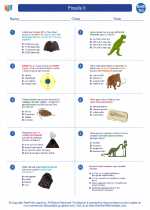Radiation
Radiation is the emission and propagation of energy in the form of waves or particles. In the context of Earth Science, radiation can refer to several different phenomena, including electromagnetic radiation from the sun, radioactive decay, and ionizing radiation from sources such as radioactive materials and X-ray machines.
Types of Radiation
Electromagnetic Radiation: This type of radiation includes visible light, infrared radiation, ultraviolet radiation, X-rays, and gamma rays. It travels through space in the form of waves and does not require a medium to propagate.
Radioactive Decay: Certain unstable isotopes of elements undergo radioactive decay, emitting alpha particles, beta particles, and gamma rays in the process.
Ionizing Radiation: This type of radiation has enough energy to ionize atoms and molecules, leading to potentially harmful effects on living organisms. Sources of ionizing radiation include nuclear reactions, X-ray machines, and radioactive materials.
Effects of Radiation
Radiation can have both beneficial and harmful effects. For example, sunlight is a necessary source of energy for plants and helps in the production of vitamin D in humans. However, overexposure to ultraviolet radiation from the sun can lead to skin damage and an increased risk of skin cancer.
Ionizing radiation can cause damage to living tissues, leading to radiation sickness, increased risk of cancer, and genetic mutations. It is important to limit exposure to ionizing radiation and take appropriate safety measures when working with radioactive materials or X-ray equipment.
Study Guide
- Define radiation and explain its various forms.
- Describe the differences between electromagnetic radiation, radioactive decay, and ionizing radiation.
- Discuss the beneficial and harmful effects of radiation on living organisms.
- Explain the concept of ionizing radiation and its potential health risks.
- Compare and contrast the uses of radiation in medicine, industry, and daily life.
Understanding the principles of radiation is important for various fields, including medicine, environmental science, and physics. It is essential to approach the topic with a strong foundation in the fundamental concepts and their applications in real-world scenarios.



